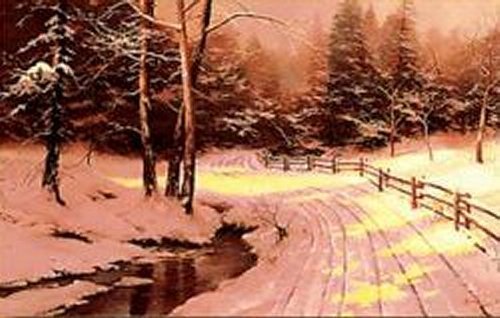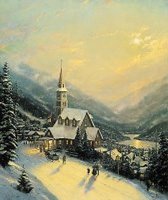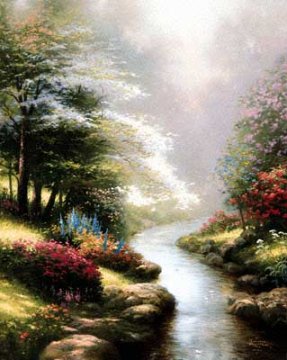Thomas Kinkade | ||||||||||||
| ||||||||||||
Music to accompany this page:
| ||||||||||||
Thomas Kinkade was born in 1958 in Sacramento, California into a family of Scottish/Irish descent. It wasn't too long after his birth, when his family moved to the nearby town of Placerville. While growing up, Kinkade began to take a keen interest in drawing, often producing pencil or watercolor paintings. At the young age of twelve, Kinkade would often wander the woods near his home, toting along his sketch pad, and drawing the elements around him. At home, values based on family, home and faith in God were being instilled in the young man, and were serving as inspiration for his drawings. By the time of his sixteenth birthday, Thomas Kinkade had begun dabbling in oils, and was now under apprenticeship to Glen Wessels, a well-know artist. Upon completion of his primary education, Kinkade turned to the University of California at Berkeley to formally study art, followed by another degree from the Art Center College of Design in Pasadena. It was during this time that Thom met fellow artist, Jim Gurney. After college, Thom secured a job within the movie industry. One of the highlights of his time there, was working on an animated feature film, titled Fire and Ice. In addition to working with Frank Frazetta, a renown science fiction artist, Kinkade created over six hundred of the background paintings, used in the film. While working on the film, Kinkade hooked up with his former classmate, Gurney, who was also Upon return from their trip, Kinkade and Gurney collaberated on a book titled "The Artist's Guide to Sketching". Based on the drawings they had done while on their cross country trek, Thom and Gary approached the method of Plein-Air Art. The book, published in 1982, quickly became a best-seller, and has continued to be ranked as a classic for pupils. In May, of that same year, Thom married his childhood sweetheart, Nanette. With his wife's encouragement and support, Kinkade left his position at the movie studio in 1983, to pursue a career as a free lance artist, creating the light-filled landscapes that he had come to With each painting, Kinkade experimented with the infusion of light on the subjects, to create a glow. Thom was not perfecting his technique, but took the approach that his style of painting is ever evolving. He has been quick to note "my style is a work in progress; I think that's true for all artists who are passionate about their craft." In Winter Glen, Thom played with light as it filters through the branches of trees, casting shadows on the path. Painted during Kinkade's formative years, this painting proved to be an extensive discovery of the After 2 years in the galleries, Thomas Kinkade began to publish his paintings. In 1989, he founded Lightpost Publishing with Ken Raasch. One of his first offerings was Moonlit Village, a painting of a church in a serene mountain side village. Images of churches have been a recurring theme in many of Kinkade's paintings. He had credited the lord for this ability to paint, 1990 brought the release of over 15 paintings by Thomas Kinkade! Included among these, were paintings dedicated to two of his daughters, Chandler and Merritt. These paintings were appropriately titled Chandler's Cottage and Evening at Merritt's Cottage. Kinkade's family consisted of four daughters, and in years to come, he would paint and dedicate warm, delicate cottages to his other two daughters, Everett and Winsor. | ||||||||||||
| ||||||||||||
| ||||||||||||
|
[ Bev Doolittle ]
[ Thomas Kinkade ]
| ||||||||||||
This Web Site and its contents (eg. HTML, design and images) are the property of Angelsmist. Please notify the author if you wish to use any of the contents or images. | ||||||||||||


 a basis in his future painting endeavors. San Francisco, Alcatraz is a fine example of Plein-Air. It was painted on a day when a historic ship happened into port, and there was a flurry of activity.
a basis in his future painting endeavors. San Francisco, Alcatraz is a fine example of Plein-Air. It was painted on a day when a historic ship happened into port, and there was a flurry of activity.

















